






























Keeping the lights on at a cost you can afford is the focal point of everything our Louisiana electric cooperatives do. Transparency is one of our core values, so in addition to sharing co-op successes, I believe we also have a responsibility to tell you about the challenges.
In May, the U.S. Environmental Protection Agency issued a rule that impacts energy production from power plants. The power plant rule will undoubtedly threaten access to reliable electricity for our local community and communities across the country.
The rule constrains existing coal and new natural gas plants by requiring them to install carbon capture and storage—a technology that has potential but has not been proven to be viable as required. No power plant in North America uses CCS at the scale and levels mandated by EPA. When power plants aren’t able to comply with EPA’s CCS requirements, they are required to shut down, significantly limit operations or switch fuels. These unrealistic standards force the unnecessary and early shutdown of many power plants that provide reliable electricity 24/7.
Renewable sources, such as solar and water, are important components of our overall generation mix. However, given the intermittent nature of these energy sources, we simply cannot depend on them—because the sun doesn’t always shine, and water levels
in our tributaries vary depending on flooding and droughts. The need for always-available power-generating resources is still essential.

The timing of the power plant rule is equally troubling. At the same time the EPA is leading our nation down the path to fewer power plants, utilities are facing a surge in electricity demand, driven by the onshoring of manufacturing, the growth of the American economy and the rapid expansion of data centers to support artificial intelligence, e-commerce and cryptocurrency.
Many states have already experienced rolling outages. If the EPA’s power plant rule further threatens the supply of electricity, the problem will only get worse. In fact, the North American Electric Reliability Corp., the nation’s electric reliability watchdog, recently forecasted that over the next five years, all or parts of 19 states are at high risk of rolling power outages during normal peak electricity demand conditions.
It’s no secret that when demand is high and supply is low, costs go up. We’re concerned about threats to reliability as well as cost increases to our members.
Staff
CEO Addie Armato
SAFETY COORDINATORS Ricky Melancon Derek Seal
COMMUNICATIONS AND DIGITAL MARKETING
SPECIALIST Conley Bourgeois
ADMINISTRATIVE ASSISTANT Rhianna Garon
CREDIT UNION
Tanya Carroll, manager
Jody Overhultz, representative
President Michael Heinen
Vice President Roger Dale DeHart
Secretary/Treasurer Richard Sitman


BEAUREGARD ELECTRIC COOPERATIVE INC.
Trent Buxton Kevin Turner
CLAIBORNE ELECTRIC COOPERATIVE INC.
Mike Marcotte Lane Davidson
DEMCO
Daniel Berthelot Richard “Dickie” Sitman
JEFF DAVIS ELECTRIC COOPERATIVE INC.
Michael Heinen Byron Hardee
SOUTH LOUISIANA ELECTRIC COOP ASSOCIATION
Trevor Benoit Roger Dale DeHart
WASHINGTONST. TAMMANY ELECTRIC COOP INC.
Joe Jarrell Dennis Glass
Associate Member PANOLAHARRISON ELECTRIC COOPERATIVE INC.

I don’t say all of this to worry you, but I do want our members to understand the challenges that lie ahead. Just as we’ve always done, we will look for solutions that serve our members best. We are joining electric co-ops across the country to fight these regulations, and we are working with our local elected officials to help them understand the consequences this could have on all Louisiana residents and businesses.
Co-ops are no strangers to innovation, and we’re taking proactive steps to address today’s energy challenges and tomorrow’s energy needs. We’ve led the charge on industry endeavors such as community solar projects, and we’ll continue to explore new technologies and strategies that bolster reliability and our local grid.
Electric cooperatives, like the member cooperatives of the Association of Louisiana Electric Cooperatives, deliver power to 42 million Americans. At the end of the day, our priority is to meet our members’ energy needs, and we must have reliable electricity available to do that.
If you’re interested in learning more about policy impacts on power reliability or to make your voice heard on this matter, visit voicesforcooperativepower.com. We also encourage you to exercise your right to vote this election season.






906 N. Lake Arthur Ave.
P.O. Box 1229
Jennings, LA 70546
337-824-4330 • 337-824-8936 (fax)
Branch office: 815 Hwy. 27, Bell City, LA 70630
337-598-5700
www.jdec.org
STAFF
Michael J. Heinen | CEO
Anya Killmer | Executive Assistant/ Benefits/HR
Eric Gautreaux | Chief Operating Officer
Tara Guinn | Chief Financial Officer
Skyler Hebert | Office Manager
Ben Hetzel | Director of Safety/ Member Services
Brennon LaBouve | Engineering Manager/ Substation & Metering
Heath Lemieux | Superintendent
Kain Miller | Superintendent, Jennings
Jonathan Nunez | Superintendent, Hackett
Wendell Thibodeaux | Purchasing Manager/ Warehouse
BOARD OF DIRECTORS
Joseph L. Tupper | President
Thomas Precht III | First Vice President
John Berken | Secretary/Treasurer
James Doxey
Byron Hardee
Wilson Dean Landry
Reggie Murphy
Kevin Sonnier
Martin Zaunbrecher
Louisiana Country (USPS 473-180) is published bimonthly by the Association of Louisiana Electric Co-ops Inc., 10725 Airline Hwy., Baton Rouge, LA 70816, in partnership with Pioneer Utility Resources.
Annual subscriptions: Members $2.30. Nonmembers $5.
Postmaster: Send form 3579 to 10725 Airline Hwy., Baton Rouge, LA 70816.
Periodicals postage paid at Baton Rouge, Louisiana 70821, and additional mailing offices.
With Election Day quickly approaching, America’s electric cooperatives continue to build momentum behind an innovative program to boost the political clout of rural America. Called Co-ops Vote, the nonpartisan campaign has one simple goal: increase voter turnout at the polls this November.
Electric co-ops are deeply rooted in their communities. Concerned that the downward voting trend would continue and could diminish the voice of rural America in future elections, co-ops sprang into action.

Participation in Co-ops Vote is strong. More than 560 electric co-ops representing all the states in which co-ops operate are taking part in the effort. More than half a million people have seen news about Co-ops Vote through social media, and several thousand have taken the pledge to get out and vote in this election.
“America’s electric cooperatives are leaders in the communities they serve throughout the country,” NRECA CEO Jim Matheson says. “Co-ops Vote focuses elected leaders on the people who are most invested in the success of their own communities. With 42 million members in 47 states, electric co-ops are a powerful voice on national issues that have a local impact.”
Anyone can take the pledge online by visiting www.vote.coop. The website provides a variety of voter resources and information on key issues, such as the importance of rural economic development and the continuing need for safe, reliable and affordable electricity.
You can show your support for rural communities by joining co-op members across the country in casting your ballot Nov. 5.

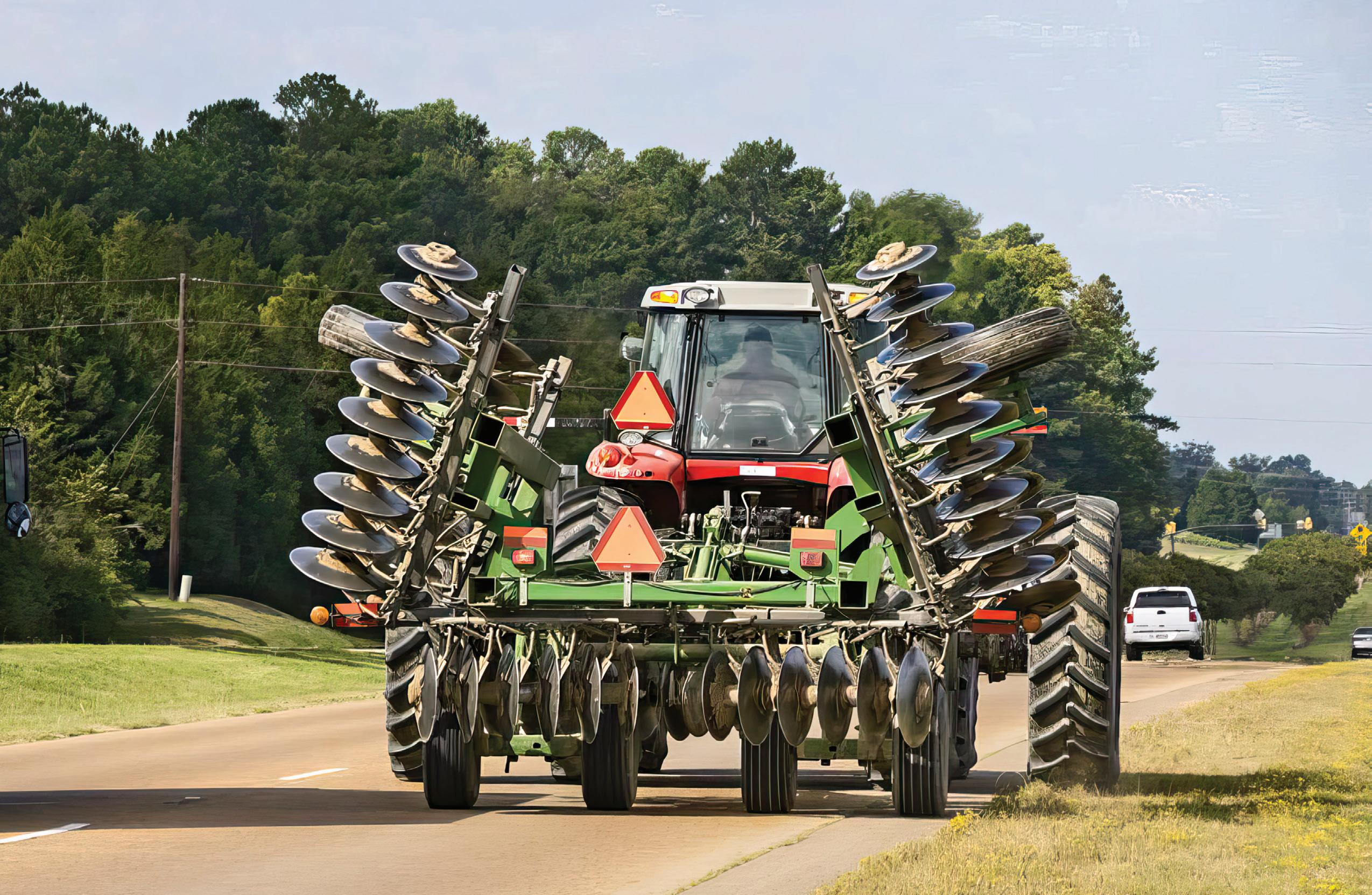


Fall harvest is a busy, and sometimes dangerous, time for farmers. Navigating roadways while driving big equipment or hauling large implements can be dangerous for farm equipment operators and auto drivers who follow behind them.
According to the National Institute for Occupational Safety and Health, 410 farmers and farm workers died in 2019 from work-related injuries. Transportation incidents, including tractor overturns, were the leading cause of death for these farmers and farm workers.
Follow these tips to help keep everyone safe.
• Make sure all flashers and lights are operational.
• Drive as far to the right side of the road as possible when going around a curve.
• Pull over and allow vehicles to pass when traffic builds up behind you.
• Take care at railroad crossings.
• Avoid traveling during busy traffic times.
• Be mindful of the height and width of machinery, watching power lines, bridges and other hazards.
• Along with turn signals, use hand signals.
• Stay rested; do not drive when you are tired or hungry.
• Keep a first-aid kit in case of accidents.
• Think about how long it will take to get to your destination and add extra time for busy farm roads.
• Give farm equipment plenty of room on the road. If a piece of oncoming equipment takes up the entire road, pull into a driveway or off to the side and wait for them to pass.
• When passing, be sure you do so in a passing zone with clear visibility. Watch for oncoming vehicles.
• Go slow. Equipment operators often stop or turn into fields. Cars going at or over the speed limit can catch up to farm machinery quickly, because farm equipment moves slowly.
• Do not assume equipment operators can move over in narrow areas; it is not always possible.
• Use extra caution when passing operators. They may not see you or know you are there because the equipment is big and noisy.
• Do not tailgate. Drivers often cannot see behind the equipment.
• Do not pass and then slow suddenly in front of equipment with implements behind it or farm trucks full of grain.
• Farm equipment makes wide turns. Give them plenty of time and room.
Following these safety tips provides a more pleasant drive for everyone.
For information about safety around electricity, including farm and ranch safety, visit SafeElectricity.org.
The Louisiana Member Services Association and Association of Louisiana Electric Cooperatives recognizes cooperative employees and their families for the volunteer work they do in their communities. This year, LMSA members decided to permanently rename two awards, one for a cooperative and one for an individual, as the Kevin Reeves Cooperative Spirit Award after a beloved cooperative employee.
Kevin spent his 33-year career at Beauregard Electric Cooperative. He was a friend to many in the industry, and he truly lived a life marked by selfless service and boundless love. Kevin’s unexpected death in June 2023 left a profound void in his family, church, community and electric cooperatives across the country. Kevin’s life was a direct reflection of everything the awards program symbolizes, and no one deserves to be the namesake of these awards more.
This year’s nominees:
Starla Pruitt, BECi. Starla runs races for benefits, fundraisers and several nonprofit organizations. Since 2018, she has competed in more than 20 races, from 5Ks to half-marathons, bringing awareness to multiple causes.
Candy Hardy, Claiborne Electric Cooperative. As a court-appointed special advocate, Candy fights for the best interest of children who have been removed from their homes by the Department of Children and Family Services.
Cecil Garaudy, DEMCO. Cecil travels to various fundraisers and volunteer opportunities with his 20-year-old African sulcata tortoise, Thomas. Cecil and Thomas are an audience favorite at their public outings, where they raise awareness and funding for various causes.
Tina Diehl, Jeff Davis Electric Cooperative. Tina provides


communications services for The Catholic Daughters of the Americas, an organization that collects new or gently used shoes for countries in need. In 2022, the group collected nearly 4,000 pairs of shoes.
William Howell, Washington-St. Tammany Electric Cooperative. William volunteers with the Liars and Lunkers free fishing tournament, which was founded
by his father and uncle. The event introduces children to the world of fishing as an alternative to drugs.
Candy Hardy was named the winner of the individual Kevin Reeves Cooperative Spirit Award.
Additionally, WSTE won the co-op award for its community project “Team Up To Clean Up/Love the Boot.” n
At the 2024 Association of Louisiana Electric Cooperatives Awards and Safety Banquet in July, cooperatives and individuals were celebrated for their accomplishments throughout the year.
ALEC provides many services to its member cooperatives, but the most beneficial and impactful offerings are the safety and training programs. Cooperative employees work in dangerous environments every day, and ALEC’s goal is to train them to do their jobs safely.
“The safety and training programs that ALEC provides are vital to our co-ops,” says Derek Seal, ALEC safety coordinator. “They ensure all co-ops are up to date on new strategies and compliant with OSHA guidelines.”
ALEC employees, with the help of toptier line professional representatives from all Louisiana co-ops, ensure all apprentices and lineworkers get the best knowledge and safe practices to be the best at what they do daily.
ALEC member cooperatives can participate in the Rural Electric Safety Achievement Program, which requires rigorous safety inspections every three years by a certified team of loss-control professionals that inspect everything from plant and equipment to employee procedures.
This year, DEMCO and WSTE completed the RESAP inspection and received a flag to display at their headquarters.
ALEC member cooperatives that have worked without a lost-time accident are given plaques in recognition of their achievements. The recipients were:
• Jeff Davis Electric Cooperative, in recognition of working more than 752,191 work hours without a lost-time accident since January 2017.
• South Louisiana Electric Cooperative Association, in recognition of working more than 4,570,467 work hours without a lost-time accident since December 1996.

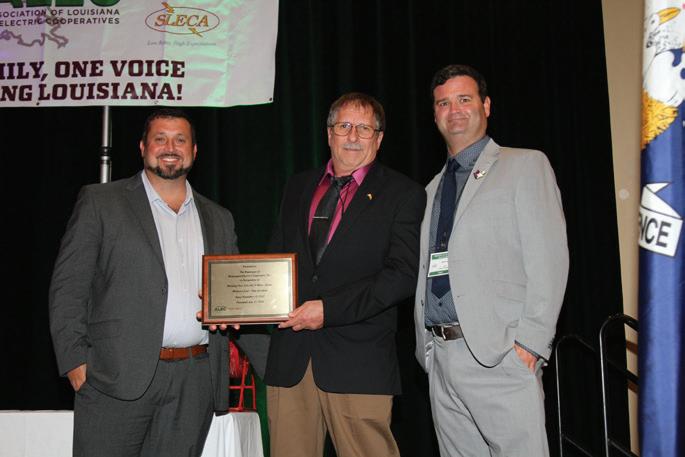
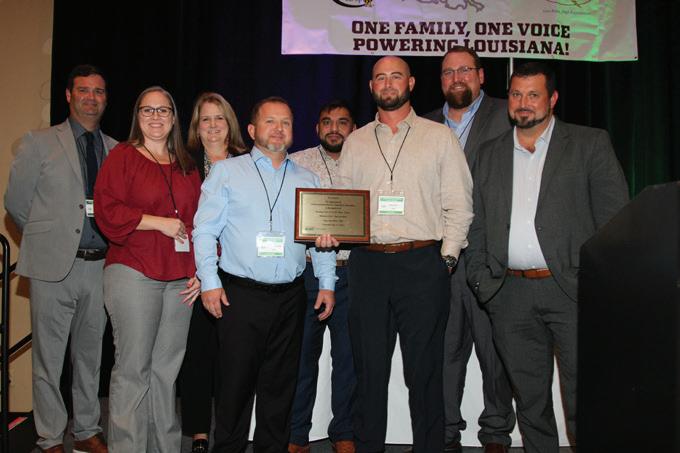
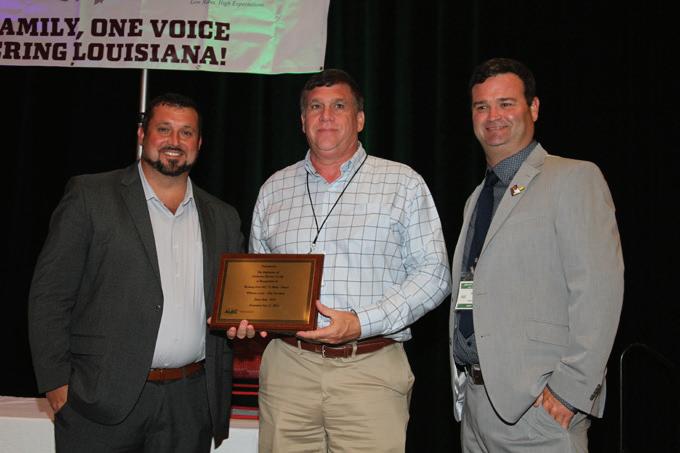
• Beauregard Electric Cooperative, in recognition of working 428,248.70 work hours without a lost-time accident since November 2022.
• Claiborne Electric Cooperative, in recognition of working more than 691,711 work hours without a lost-time accident since June 2019.
The Traveling Statewide Safety Award is always the last presentation. A special formula is used to determine the winner, incorporating employees’ incidents, incident severity, hours worked and vehicle accidents.
Jeff Davis Electric received the prestigious statewide safety trophy for the second year in a row.
ALEC commends all member cooperatives for their achievements and continued commitment to safety. n
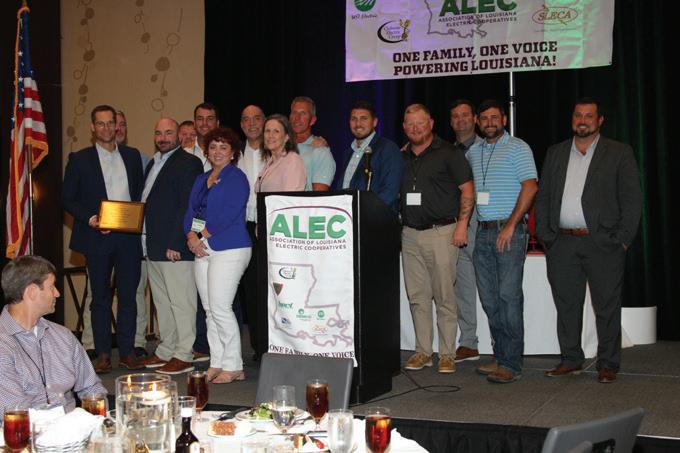
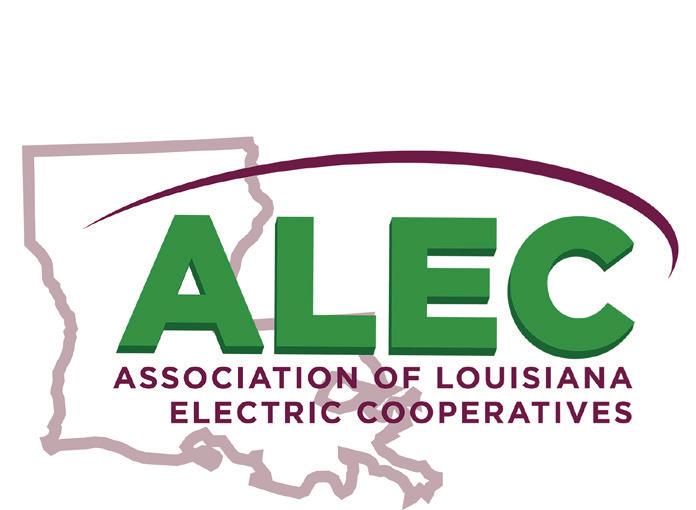










|












































































Story and photos by John N. Felsher









Well known for producing giant speckled trout, the Calcasieu Estuary south of Lake Charles offers anglers more to catch.
Calcasieu Lake, locally known as Big Lake, runs about 12 miles long by 9 miles wide and covers roughly 50,000 acres. The Calcasieu Ship Channel runs 40 miles from Calcasieu Pass on the Gulf of Mexico to Lake Charles, connecting Big Lake and other water bodies.

To the west, the Sabine River flows down the Louisiana-Texas line into Sabine Lake. Sabine Lake spreads across 45,320 acres. At the south end, Sabine Pass connects the lake to the gulf.
The Gulf Intracoastal Waterway connects the Calcasieu Ship Channel to Sabine River. A vast brackish marsh provides outstanding angling opportunities for multiple fish species between the two major lakes from the GIWW south to the gulf.
Sabine National Wildlife Refuge conserves nearly 125,000 acres of this pristine wilderness punctuated by numerous impoundments, bayous, canals and ponds. In the marshes between the lakes, anglers can catch anything that swims in Louisiana waters.
Fresh water from the Sabine and Neches rivers pours into the northwestern portion of the marshes, where it mixes with salty




water coming from the gulf through the passes. On the eastern side, fresh water pours down the Calcasieu River into the northern part of the Calcasieu Estuary.
The blurred demarcation between the two environments blends and moves constantly as river flow, tides and wind battle for dominance. This fertile mixing of sweet and saline worlds creates a piscatorial gumbo, providing homes to a multitude of diverse species.
Predators feast upon the best forage from both worlds. Bass, redfish, trout and flounder gorge themselves on a rich smorgasbord of aquatic and marine morsels such as threadfin shad, crawfish, bream, crabs, shrimp, cocahoe minnows, menhaden, known locally as pogies, mullets, croakers and uncountable other creatures.
Largemouth bass can tolerate salinity up to about 10 parts per thousand. Blue catfish can tolerate salinity better than most other freshwater species. Redfish and flounder can live in pure, fresh water. Most other salty species tolerate varying salinity levels. On any day, the catch might include these fish, plus speckled trout, white trout, black drum, sheepshead, several bream species, crappie, fresh and saltwater catfish and others.
“Many diverse species hang out all together in the same places,” says Tom Adams Jr. of Fishing Tom Guide Service in Sulphur. “It’s not too salty for freshwater species, and it’s salty enough for many saltwater species. We might catch 15 or more different species in one day.”
What one catches in a particular spot at any given time depends upon salinity levels at that spot, which can sometimes fluctuate hourly. Anglers might catch mostly bass from one spot early in the morning or some redfish and flounder. Later in the day, they might catch mostly speckled trout in the same spot with the same baits.
“Most bass in the marsh average about 1 to 2 pounds, but anglers specifically targeting bass sometimes catch 5- to 6-pounders,” Tom says. “In some bass club tournaments, anglers have caught bass in the 8- to 10-pound range.”
Nothing ignites a multispecies feeding frenzy like a fall crustacean migration. After a good cold snap, white shrimp leave the estuaries to head for deeper waters. As shrimp move, everything follows. No predator will refuse a shrimp snack. Largemouth regularly hit live shrimp or soft-plastic shrimp imitations, such as Vudu, D.O.A. or Gulp!, fished under a popping cork.

“Bass absolutely love live shrimp,” Tom advises. “In September and into the fall, we fish grass lines with live shrimp under a popping cork for both bass and redfish. For redfish, I like to work the main bayou shorelines. I look for flowing water. We also catch many flounder in the same places, especially in the fall.”

Black Bayou flows through the northwestern portion of those marshes and provides excellent fishing opportunities for varied species. Multiple small tributaries feed into the bayou. During a falling tide, dropping water levels pull baitfish, shrimp, minnows and crabs from the marshes and ponds into deeper water. Bass, redfish, flounder and other species wait at the mouths of small drains to ambush anything washing out with the tide.
“Black Bayou can produce excellent action,” Tom says. “It usually has moving water. The bayou averages about 8 to 10 feet deep, but some holes drop to 14 feet deep. Redfish like to hang out in the holes as water temperatures cool in the fall.”
In the drains, many anglers fish live shrimp, or a soft-plastic shrimp imitation, under a popping cork. Toss the cork as far up the drain as possible. Let the tide carry the cork naturally downstream. Use the reel only to take up slack and keep the bait in the flow.
Anglers can also fish the Vinton Drainage Ditch, which crosses the Intracoastal and merges into Black Bayou. The East Cut connects the north end of Sabine Lake to Black Bayou.
“Trout action depends largely on salinity levels,” Tom says. “We usually find specks closer to Sabine Lake. In the marshes, trout average about 12- to 15-inches long, but it’s not uncommon to catch a limit of 15-inch trout, especially in the fall.”
Closer to the Calcasieu side, the Black Lake area produces great fishing action for trout and other salty species. The Salt Ditch runs from the GIWW to the Black Lake area and regularly produces good trout action. Kelso Bayou connects Black Lake to the Calcasieu Ship Channel. People can fish off the bank along Highway 27.
“The waters around Black Lake are very good for redfish, trout, flounder and other saltwater species,” Tom says. “In the marshes, we never know what might grab the line, especially when we put a live shrimp on a hook. It’s always a surprise what we bring in. That’s what makes fishing this area so exciting!”
For information on Sabine National Wildlife Refuge, visit www.fws.gov/refuge/sabine. For area information, go to www.visitlakecharles.org.
To reach Fishing Tom Guide Service in Sulphur, call 318-675-9114 or go to www.fishingtom.net.

Voting is one of the most powerful ways to make your voice heard in our democracy, but in 2020, only 66.8% of the voting-age population in the United States reported voting.
Modern technology has improved access to information on candidates and made it easier to register to vote in many areas, and it is vital to be aware of how you can participate in the 2024 election cycle.
LOUISIANA’S ABSENTEE AND MAIL-IN VOTING PROCEDURES
Permanent absentee / mail-in voting procedures:
Excuse required to request an absentee ballot Applications can be submitted via mail, in-person, email, fax, and online
Early Voting Begins: October 22, 2024
Early Voting Ends: October 29, 2024

VOTER REGISTRATION DEADLINE: October 6, 2024
30 days before an election; 20 days before if registering online.
ABSENTEE / MAIL-IN VOTING BALLOT DEADLINES:
Request must be received by
November 1, 2024
4 days before the election at 4:30 p.m.
To register to vote in Louisiana, visit the State Board of Elections website for more information on voter eligibility and the registration process.
BALLOT SUBMISSION DEADLINE:
All absentee ballots, regardless of return method, must be received the day before the election.
You can begin the registration process through Louisiana’s Online Voter Registration System.







Committee for Rural Electrification® (ACRE®) to electric cooperatives in their local just that.
action committee (PAC), and it continues to to electric co -ops.

it’s impo rtant that candidates who receive the PAC and the electric cooperative conduct research to ensure electric co -ops research and discussions with individuals that many of today’s political candidates
An effort to support policymakers and initiatives that further the cooperative mission received a fresh name last year: America’s Electric Cooperatives PAC. As it goes into its first presidential election season, the organization continues a mission that began nearly six decades ago.
for our PAC: America’s Electric Cooperatives

A political action committee, or PAC, allows donors to support political candidates. Thousands of donors have contributed to the America’s Electric Cooperatives PAC, according to the National Rural Electric Cooperative Association.
“The name change just makes sense,” says Gabe Snow, the PAC’s director. “If we’re going to have a large PAC, we need to make sure it’s identified appropriately to help ensure electric co-ops are recognized for our collective efforts.”
activities of the PAC under the well-known and resources, including the Voices for Cooperative recognizable brand that enhances our reputation. This electric co-ops is purposefully designed to elevate evidence that this approach is working well.

Discussions with individuals associated with federal politics and PAC donors found many of today’s political candidates did not connect ACRE with electric co-ops.
So, NRECA unveiled America’s Electric Cooperatives PAC last year, enabling the association to better connect PAC activities to the nation’s well-known and respected co-ops. The rebrand created an umbrella encompassing not only the PAC but also other advocacy resources, such as the Voices for Cooperative Power grassroots network.
That vision led to a name change for the PAC that began in 1966, when NRECA established the Action Committee for Rural Electrification, known as ACRE.
At the time, the use of acronyms to identify such groups was less common than it is today. Research supported by NRECA indicated co-ops did not receive full recognition for their collective efforts.
through personal dollars raised from co -op candidates, who if elected become

“The name America’s Electric Cooperatives PAC capitalizes on the fact that electric cooperatives are already held in high regard in Washington, D.C., through our collective advocacy efforts,” Gabe says. “It capitalizes on that brand and the reputation NRECA has as a strong bipartisan organization.”
A simple, straightforward PAC name is especially important in dealing with first-time federal candidates, Gabe says.
“Every two years, hundreds of congressional elections take place, and new candidates enter the field,” he says. “That constant churn happens over and over again, and it’s easy to get lost in the alphabet soup of acronyms in Washington.”
America’s Electric Cooperatives PAC allows electric co-ops to financially support federal candidates.
Funding: Funds include personal dollars raised from co-op leaders and consumer-members.
The goal: The PAC strives to ensure that candidates, if elected, become policymakers who connect the PAC with electric co-ops.
member co -ops and the feedback we’ve received to manage America’s Electric Cooperatives at NRECA PowerXchange.
The details: America’s Electric Cooperatives PAC is nonpartisan, advocating for policies and legislation supporting our electric co-ops.
For more information or to donate, visit cooperative.com/pacdonation.


have a robust Voices for Cooperative Power op employee and consumer-member tap into thousands of cooperative CEOs and and regulatory advocacy teams at NRECA.
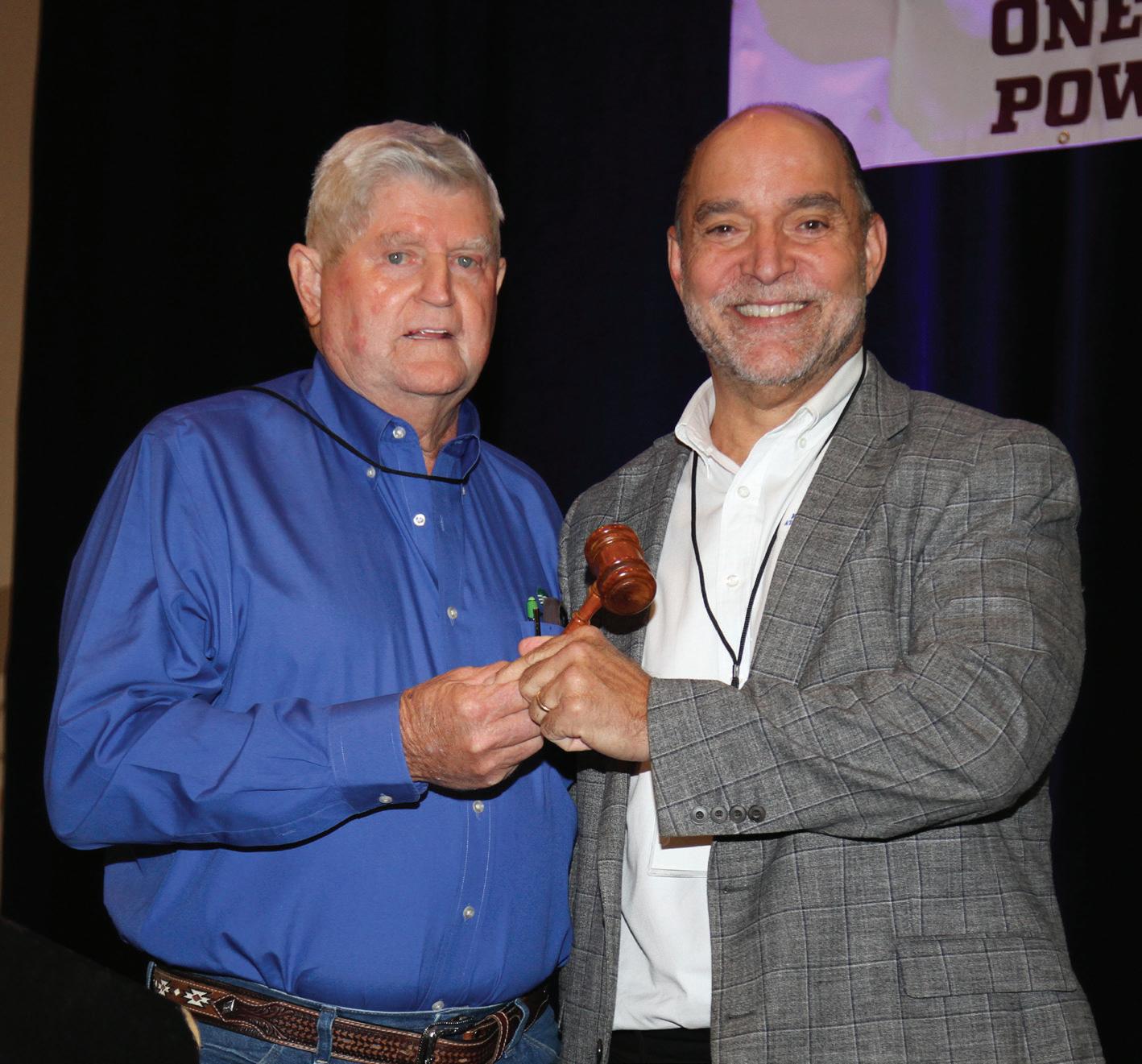


CLOCKWISE FROM ABOVE: Association of Louisiana Electric Cooperatives outgoing board president, Dennis Glass of Washington-St. Tammany Electric Cooperative, passes the gavel to the newly elected president Mike Heinen, CEO of Jeff Davis Electric Cooperative. Roger Dale DeHart of South Louisiana Electric Cooperative Association was elected as vice president. The 2024-2025 secretary/treasurer is Richard Sitman of DEMCO.
New directors and officers announced
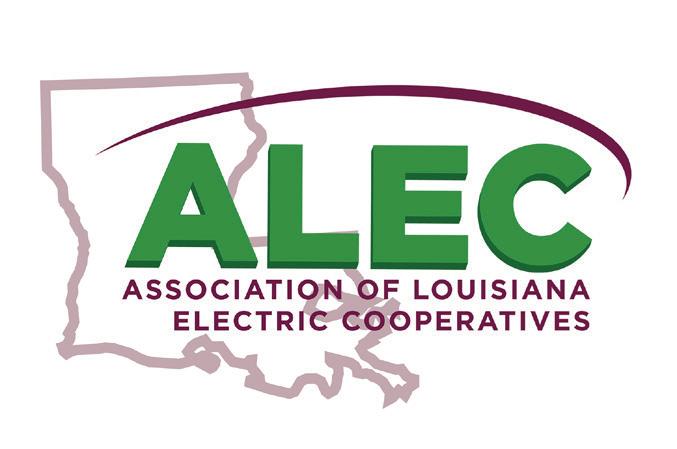
At the 2024 Association of Louisiana Electric Cooperatives Annual Meeting, the ALEC Board of Directors elected the following slate of officers for 20242025: President Mike Heinen, Jeff Davis Electric Cooperative; Vice President Roger Dale DeHart, South Louisiana Electric Cooperative Association; and Secretary/ Treasurer Richard Sitman, DEMCO.
“I am excited to continue to contribute to our cooperatives’ shared vision,” said Heinen. “We are well positioned to make a lasting impact on the communities we serve.”
Also appointed by their respective cooperatives to serve three-year terms as ALEC drectors are Mike Marcotte, Claiborne Electric; Dennis Glass,
Washington-St. Tammany Electric Cooperative; and Trent Buxton, Beauregard Electric Cooperative Inc.
“We are proud to announce our new board of directors and officers,” said ALEC CEO Addie Armato. “Our board of directors has been instrumental in providing our statewide organization with strategic guidance to better serve our cooperative members. We value their ideas and give them an equal voice at the table.”
Under the direction of the board, ALEC will continue to provide its members with innovative educational opportunities, award-winning magazines, safety and loss control programs, and a strong presence in both legislative and regulatory matters. n
Modern farming often relies on data and equipment with GPS and auto-guidance systems. However, even with these modern conveniences, farm workers must remain vigilant. That’s because farming is considered one of the most dangerous jobs.
Massive machinery is indispensable to farming, but the same impressive size, height and extensions make them particularly vulnerable to contacting power lines. That’s why staying alert, focused, and knowledgeable about potential hazards and safety procedures is crucial.
During a busy harvest season, the familiar sights around the farm can easily fade into the background, and farm workers can overlook the power lines overhead. However, failing to notice them can lead to deadly accidents.
Awareness of your surroundings around, above and below, as well as planning safe equipment routes can significantly reduce the risk of accidents. Even with GPS and auto steering, it’s imperative that farm workers keep a close eye on the equipment’s location and are ready to act if necessary.
Exposed underground power lines, defective wiring in farm buildings and extension cords are also hazards.
Grain bins can pose a potential danger as well. The National Electrical Safety Code requires power lines to be at least 18 feet above the highest point on any grain bin with which portable augers or other portable filling equipment are used.
If you plan to install new grain bins or you’re concerned about the proximity of power lines to existing grain bins, contact Escambia River Electric Cooperative.
To ensure a safe harvest season, SafeElectricity.org recommends the tips in the graphic below to avoid electrical accidents on the farm.
While rare, an equipment fire is the only reason to exit machinery that has come into contact with overhead lines. If it happens, jump off the equipment with your feet together. It’s critical you not touch the machinery and the ground at the same time. Then, still keeping your feet together, hop to safety as you leave the area. n



































Jeff Davis Electric Cooperative won the prestigious statewide traveling safety trophy for the second year in a row at the Association of Louisiana Electric Cooperatives Annual Meeting in July. Several members of the JDEC team accepted the award.


a
awarded the Good Samaritan Award for
from

By Victoria Hampton



items your household may need in the event of a shelter-in-place or evacuation emergency. See a list of kit items on page 7.
Be prepared. These two words of advice can make all the difference when facing severe weather and natural disasters. While some severe weather events are seasonal, unpredictable conditions can cause natural disasters to strike any time of year. There is no better time than today to start planning for the next emergency in your community.


During National Preparedness Month, take steps to prepare for what Mother Nature has in store by creating an emergency plan. Emergency plans should account for multiple emergency scenarios. The plan should be developed, discussed and shared with all members of your household.
Take these steps to prepare your emergency plan:
Communicate. Because your family or roommates may not be together when a disaster strikes, make sure everyone knows how to contact one another and where to reconnect.
Discuss the types of disasters that are possible in your area and the different precautions for each. For example, wildfires have different evacuation levels, from 1 to 3. Hurricanes are defined by severity categories. Make sure everyone knows recommendations for sheltering in place and evacuation based on the severity of the natural disaster or storm.
While building your kit, consider the unique needs of each member of your household, such as medication, dietary restrictions, pet supplies and necessities for specific ages. Depending on the size of the household, an emergency kit may be one waterproof container or multiple bins.

If buying extra supplies for an emergency is not in the budget, start with what you already have at home. Collect items in one area to create a new storage spot. Use this nonperishable storage as an extension of your food pantry. Take and replace items after grocery shopping to avoid food waste, and keep the emergency kit stocked at all times. Consider adding additional, non-food items to your kit on a weekly or monthly basis, as finances allow. For emergency kit tasks listed in manageable weekly or monthly steps, search online for a disaster supplies and preparedness calendar.
Ensure the emergency kit is stored in a dry place that is easily accessible for shelter-in-place and evacuation emergencies, such as a garage or closet near the front door. If you leave home for work, make an emergency kit to keep in your vehicle or at your office. Keep in mind, sheltering in place may mean staying at work or a public place if you cannot safely return home.

Talk about how your family would respond to different types of emergencies. Document the plan and share it with each person in the household. Ready.gov offers an easy family emergency communication plan that can be filled out and exported into a shareable PDF.
Expand your emergency plan to include neighbors. Talk about emergency resources or tasks you may be able to share, how to help neighbors who have disabilities or are elderly and how you will communicate with them during a disaster.
Build an emergency kit. A crucial part of creating an emergency plan is building an emergency kit. Emergency kits consist of basic
Sign up for alerts. Finding up-to-date information during an emergency can be stressful. Set up access to emergency alerts beforehand to receive up-to-date information.
Check in with city or county offices of emergency management to sign up for emergency alerts. Signing up for these notifications allows emergency response agencies to text, call or email when a local emergency may require you to shelter in place or evacuate. Local emergency management may also have recommendations for additional alerts and online resources for the most common natural disasters in your area.
The Federal Emergency Management Agency mobile app offers alerts and resources before, during and after a disaster. Get severe



weather alerts for your area, find local evacuation shelters and disaster recovery centers, save custom emergency information, and receive safety and preparedness reminders. The app is available in English and Spanish. Download for free in the Google and Apple App stores on your smartphone.
Prepare for evacuation. While it may seem unthinkable to have to leave home during severe weather, many kinds of disasters can lead to evacuation. Sometimes there is a day or two to prepare. Other times, a life-threatening situation leads to immediate departure from home.

Prepare evacuation plans by identifying several places to go in an emergency, such as a friend’s house, nearby town or motel. Ask local emergency management about available shelter spaces, and include those options in your plans.


temporarily housed. For small pets, check hotel and shelter policies or ask friends about options at their homes. For large animals, check with local fairgrounds for shelter policies during emergencies, and research additional livestock evacuation locations.
In case of immediate evacuation or shelter-in-place orders when away from home, make sure pets and livestock are microchipped or tagged to expedite reunification efforts post-disaster.
During storm season, keep your vehicle’s gas tank as full as possible. Along with aiding in evacuation to a safer area, vehicles can be used as temporary shelters.

No one wants to deal with the stress and fear of a natural disaster. Yet having a plan for you and your family is the difference between a life-threatening situation and safely weathering the storm.
Choose a variety of locations in different directions. Some of your top choices may be affected by a storm or disaster.
For pets and livestock, identify places where they can be
Information for this article was sourced from the United States Department of Homeland Security. Visit ready.gov for free emergencyplanning resources.


An emergency kit is a collection of food, water and supplies that can sustain you and your family for multiple days. When building a kit, choose a waterproof container with a secure lid, such as a storage bin. An emergency kit could be one bin or several, depending on the number of people in your household.
This list is broken into basic items to start a kit and additional recommendations provided by the United States Department of Homeland Security.
At a minimum, your emergency kit should include the following items:
• Bottled water (1 gallon per person per day for several days).
• Nonperishable food.
• Battery-powered or hand-crank radio and a National Oceanic and Atmospheric Association weather radio with tone alert.
• Flashlight.
• First-aid kit.
• Extra batteries
• Whistle to signal for help.
• Dust mask to help filter contaminated air.
• Plastic sheeting and duct tape to shelter in place.
• Moist towelettes, garbage bags and plastic ties for personal sanitation.
• Wrench or pliers to turn off utilities.
• Manual can opener.
• Local maps.
• Cellphone with chargers and a backup battery.
• Pet food and water.
• Proper identification.
• A carrier or portable kennel.
• Collar and leash.
• Food and water bowls.
For additional recommended items to add to an emergency kit, visit ready.gov/kit.
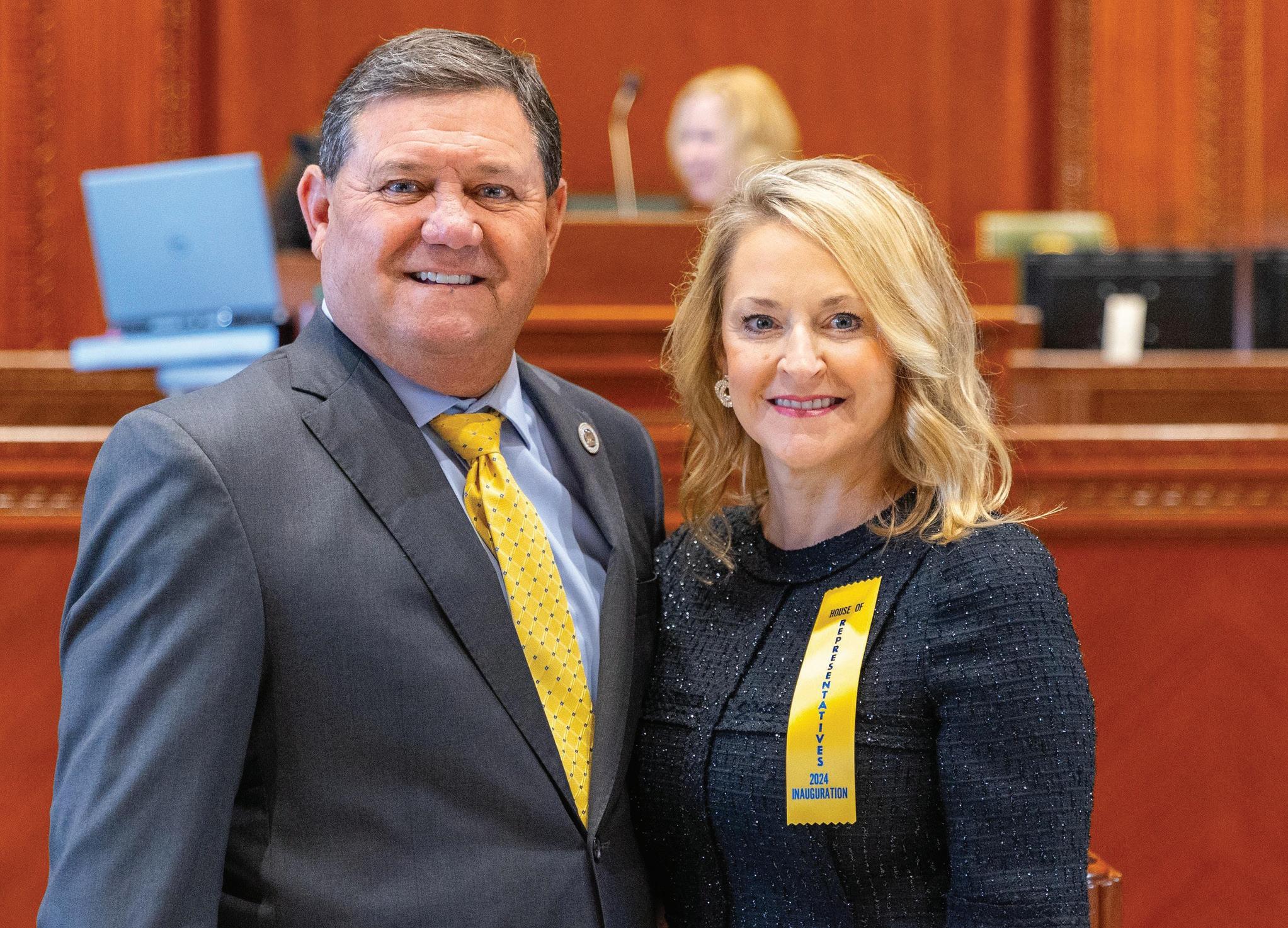
By Conley Bourgeois
The foundation on which cooperatives were formed and still adhere to is the Seven Cooperative Principles. The third principle is Democratic Member Control. This concept gives you a voice as an owner of the cooperative and allows you to exercise your right to vote for a director in your area.
Troy Romero, a Jeff Davis Electric member and District 37 state representative, believes in the power of voting as a cornerstone of American independence.
“Your vote does matter,” he says.
Starting his political journey on the police jury for Jeff Davis Parish, Troy recognized early that public service was his calling. Now, as the chairman of the Agriculture, Forestry, Aquaculture and Rural Development Committee, he makes informed decisions
for local, like-minded people. After growing up working on his family farm in Welsh, Troy knows and understands what local people need.
Transitioning into a state representative after the police jury, Troy takes his responsibilities to heart.
“My duty is to represent the people I serve,” he says. “When I vote, it reflects their voices—just like voting for your local board member at Jeff Davis Electric.”
Your board of directors represents you and relies on your support to improve the cooperative.
Troy encourages everyone to register to vote and has some advice.
“Stay involved and stay engaged,” he says. “Educate yourself and form your own opinion.
National Voter Registration Day is Tuesday, Sept. 17. Register online at www.vote.gov.
Throughout United States history, a number of important events were decided by just a few votes. From presidential elections to policy to local co-ops, your vote makes a difference. Visit www.middletonma.gov/303/The-Power-of-One-Vote for more examples.















Thomas Jefferson was elected U.S. president by one vote in the House of Representatives after a tie in the Electoral College.











Republican Randall Luthi and Independent Larry Call tied for a seat in the Wyoming House of Representatives from the Jackson Hole area.
A recount produced the same result. Luthi was finally declared the winner when a ping pong ball bearing his name was pulled from the governor’s cowboy hat.









The U.S. Senate passed the convention annexing Texas by two votes (27-25).











Joe Courtney won Connecticut’s 2nd U.S. Congressional seat with 121,252 votes to Rob Simmons’ 121,158; a difference of only 91 votes.









Governors of Maine, Rhode Island and North Dakota were elected by an average of one vote per precinct.









Let your voice be heard. Your vote can make a difference in the upcoming election.




By Scott Flood

Unless you’ve just awakened from an especially long nap, you’ve probably been hearing plenty about artificial intelligence. It’s likely that much of what you’ve heard is exciting or terrifying. Movies and TV offer paradises in which technology frees us from daily drudgery—and frightening scenarios in which machines become our overlords.
Venkat Banunarayanan smiles when asked if popular media’s takes on AI are accurate.




“We’re at the stage of discovery with AI,” Venkat says.


What could AI, VR and AR mean for electric co-ops?

“There’s a lot more buzz than reality at this point, and we have a long way to go.”
As the vice president for Integrated Grid Business & Technology Strategies for the National Rural Electric Cooperative Association, Venkat spends some of his time exploring possible use cases with AI, augmented/virtual reality and other technologies, while considering how they might improve the way electric co-ops serve their consumer-members.

“Can AI do things better? Can it handle some of the tasks we have to do today? Can it make decisions for us? The answer to those and most other questions is the same: maybe,” he says.
Industry experts agree it’s impossible to guess where AI will be in another decade or two, but it’s currently not as powerful as the entertainment industry and media seem to think.
AI is being incorporated for specific tasks and activities, including automated solutions such as chatbots that are capable of answering common questions. AI also has the potential to be paired with data analysis, such as retailers using data to better predict customer needs.

Despite what you may have heard, AI is incapable of thinking independently. The functionality greatly depends on programming, how the tool is trained to handle specific tasks and the level of data being fed into the system. AI revolves around learning and adapting to decision-making.



Because these new technologies interface with internal and external systems, Venkat stresses the importance of strong cybersecurity.
“We need to make sure hackers can’t




influence systems,” he says. “When we consider advancements like AI, we need to ensure protection of personal, critical infrastructure, proprietary and confidential data, too.”


Maintaining robust cyber hygiene is important and necessary to deploy any technology reliably and safely—AI is no different.
As electric cooperatives explore the possibilities of AI, they will focus on underlying needs rather than the technology itself. Examining better ways to accomplish tasks and obtain desired results will guide co-ops as they consider AI tools for more efficient processes and approaches.
Despite all the hype, today’s AI is mostly used to make incremental improvements to existing products and services. That’s how electric co-ops are likely to experience the growth of AI in the foreseeable future.

For example, the next generation of smart meters might incorporate AI tools that help homeowners better manage energy use. AI-based systems may also be used to improve management of the nation’s power grid, spotting potential problems before human operators can.
Electric cooperatives already use artificial intelligence and augmented reality for key tasks and activities.


Looking ahead, co-ops see great potential for AI and AR as helpful tools for improving grid reliability and the services they provide to consumer-members.
AI tools like chatbots can enhance member interactions and provide a tailored experience based on energy use data.
With the help of AI, weather forecasts will become more accurate, pinpointing areas to station utility crews.

Weather forecasts are likely to become more accurate, pinpointing the areas most likely to experience damage so crews can be stationed there.
Another promising technology being explored is augmented reality, and some co-ops are already testing it, particularly in educational and training opportunities.


For example, apprentice lineworkers can become comfortable with the equipment by working with the AR and VR versions before working with the real thing. Instead of watching a video or a webinar, lineworkers can interact with what they’re doing. Safety training can simulate a hazardous situation, like the aftermath of an ice storm or hurricane, providing lineworkers the opportunity to prepare for the real thing.
AR blends VR with the world around us.
One day soon, a lineworker may look up at a failed transformer

Through augmented reality, lineworkers can experience interactive, lifelike trainings, rather than watching a video or webinar.


atop a power pole. Their safety glasses will instantly recognize the type of transformer, its exact location and when it was installed before displaying a checklist of the equipment the lineworker may need, a guide to diagnosing common problems and 24-hour access to technical experts.
Ultimately, the adoption of AI, VR, AR and other technologies share one goal for electric co-ops. From solving outages more quickly to allowing consumer-members greater control over their energy use to lowering the cost of service, tomorrow’s innovative technologies will continue to help co-ops enhance the services they provide to communities.






As summer comes to an end, assess the health of your home to maximize savings
A programmable thermostat allows you to control settings to suit your climate, schedule and temperature preferences.
Consider installing a smart thermostat. After installation, input your schedule and temperature preferences. As you change the settings, the thermostat adjusts to minimize energy use. Bonus: You can control the thermostat remotely with a smartphone.
Don’t adjust the thermostat drastically. Your home will not heat or cool more quickly.
Keep the temperature at or below 68 F during the day and cooler at night.
Save up to 10% on your monthly heating and cooling bill by turning back your thermostat 7 to 10 degrees for eight hours a day.
Energy loss and drafts often occur in the cracks between window components. Use weatherstripping where a window’s movable parts meet the window frame.
The seam between the window frame and the wall is a common source of air leakage. Fill any crack less than ¼-inch wide with caulk. For larger cracks, use expanding foam and paint over it. Use window coverings to cut energy costs. Cellular shades, curtains and draperies can provide increased comfort year-round.
Use a door sweep—a flexible piece of rubber or plastic held to the door’s lower edge by a piece of aluminum—on an exterior door to block drafts.
Insulation reduces heat loss during winter and heat gain during summer. Before you add or replace insulation, check your current levels. Start with your attic. Aim for at least 14 inches of insulation for warmer climates and at least 18 inches in colder climates. The U.S. Department of Energy recommends an R-value— which refers to the insulation’s ability to resist heat—of about R-60 for most regions.
According to DOE, air leaks are among the most significant sources of energy loss in a home. They also are the easiest to fix. Check for leaks throughout your home, including insulation.
Frequently replacing your furnace filter is one of the easiest and cheapest ways to keep your HVAC system running efficiently. A clogged filter causes your system to work harder and can shorten its life span.
Depending on the home, filters should be changed every month or every other month when the HVAC system is in use.
Schedule an annual service on your HVAC system. A clean system is safer and more efficient. A preventive service call for a tuneup and cleaning usually is less expensive and less stressful than an emergency service call if your equipment fails.
Leaky furnace ducts mean higher utility bills. Improve their performance by sealing exposed ducts in the attic, crawl space, unfinished basement and garage.
Trim shrubs, and clear leaves and other debris. Keep branches away from the house and electrical wires to prevent property damage or power interference. Cut cracked and diseased limbs close to the trunk. For large jobs, hire a pro.
Rake yard debris away from the outdoor compressor unit of your heat pump. A heat pump needs good circulation to work efficiently, so make sure there is a 2-foot clearance around the outdoor compressor.
Ensure gutters are clear and downspouts are correctly connected so water drains away from your home. The dirt grade around your home should slope away from the house.

